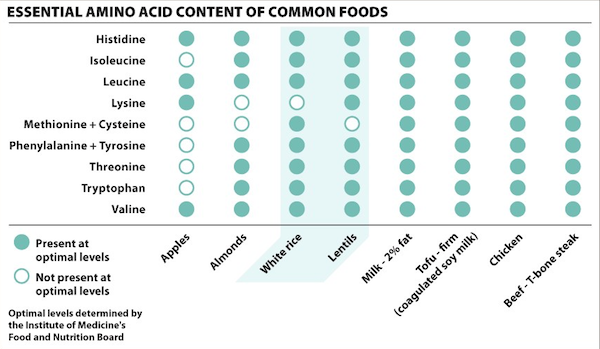Chapter 2. Chapter 2 Graphic Content
Introduction
Graphic Content
true
true
You must read each slide, and complete the question on the slide, before proceeding to the next one.

Instructions
Review the information provided in the graph to answer each question below.
After submitting your answer, you will be provided feedback to check if your response is correct.
(This activity contains 7 questions.)
Question 2.1

A blue dot in a column indicates that the food summarized in that column carries the optimal level of the amino acid(s) listed for that row. A white dot indicates that the food does not contain optimal levels of that amino acid(s). For example, lentils contain optimal levels of the amino acid cysteine, but white rice does not.
Question 2.2

There is a large amount of information in this figure. One very important conclusion you can draw is that some food sources of protein contain all of the essential amino acids, but others, mostly from plants, do not contain all of the essential amino acids.
Question 2.3

Although neither of these foods, alone, is a complete protein, consuming them together provides all of the essential amino acids at optimal levels.
Question 2.4

You don’t necessarily have to avoid such a food. It is not necessary to get all of the essential amino acids from each protein source. As long as you get all of the essential amino acids from everything you consume at a meal, you will not have any amino acid deficiencies.
Question 2.5

Apples and white rice, consumed together, would contain all of the essential amino acids. Lentils and almonds would not, since neither of these foods contains methionine and cysteine.
Question 2.6

The figure doesn’t specify what the “optimal levels” of an essential amino acid are. The word “optimal” seems a bit subjective, and the figure doesn’t specify who determined what constitutes an “optimal” level. This could be cause for some caution in interpreting the data. In fact, though, these levels were determined by the Institute of Medicine’s Nutrition Advisory Board. The Institute of Medicine is the health arm of the U.S. National Academy of Sciences, a highly respected group of the country’s most distinguished scientists.
Question 2.7

The amount of a food you must consume to get a sufficient amount of all the essential amino acids is not given. We can assume that a standard serving is sufficient, but it would be helpful if specific amounts were given, such as “8 ounces” of 2% fat milk, or “6 ounces” of chicken breast.
Activity results are being submitted...